Should Waste Separation Be Mandatory? A Study on Public’s Response to the Policies in China
Abstract
1. Introduction
2. Study I: The Response Study of Rigid Waste Separation Policy
2.1. Research Method Selection and Process Design
- Use Python to write crawlers, crawl the required data, and carry out simple cleaning and sorting;
- Use stuttering participles to cut the data and transform the text into independent entries;
- Analyze the processed text through sentiment analysis, keyword analysis, and other methods, and then draw relevant conclusions.
2.2. Data Acquisition and Pre-Processing
2.3. Sentiment Analysis
2.4. Keyword Analysis
3. Study II: The Response Study of Flexible Waste Separation Policy
3.1. Scale Design
3.2. Formal Research and the Testing for Reliability and Validity
3.3. Result Analysis
4. Discussion
5. Conclusions
Author Contributions
Funding
Conflicts of Interest
References
- National Bureau of Statistics of the People’s Republic of China (NBSPRC). China Statistical Year Book, 2019. Available online: http://www.stats.gov.cn/tjsj/ndsj/2019/indexch.htm (accessed on 22 April 2020).
- Chen, F.; Wang, F.; Hou, J. Individual preference framework or group preference framework? Which will regulate the impact path of product facilities on residents’ waste-sorting behavior better. Int. J. Environ. Res. Public Health 2020, 17, 2324. [Google Scholar] [CrossRef] [PubMed]
- Ministry of Housing and Urban-Rural Development of the People’s Republic of China (MHURD). Notice on Announcement of Pilot Cities for Separate Collection of Waste. 2000. Available online: http://www.mohurd.gov.cn/wjfb/200611/t20061101_156932.html (accessed on 22 April 2020).
- State Council of China. Implementation Scheme of Domestic Waste Separation System. 2017. Available online: http://www.gov.cn/zhengce/content/2017-03/30/content_5182124.htm (accessed on 2 April 2020).
- The People’s Network. Shanghai’s “Strict Waste Sorting” Has Been in Operation for Four Months, with Results far Exceeding Expectations. 2019. Available online: http://js.people.com.cn/GB/n2/2019/1124/c359574-33570498.html (accessed on 22 April 2020).
- Gaebler, S.; Niklas, P.; Felix, R. Compulsory voting and political participation: Empirical evidence from Austria. Reg. Sci. Urban Econ. 2020, 81, 103499. [Google Scholar] [CrossRef]
- Hockenstein, J.; Stavins, R.; Whitehead, B. Crafting the next generation of market-based environmental tools. Environment 1997, 39, 12–33. [Google Scholar] [CrossRef]
- David, P.; Richard, G.; Adam, B. Energy, the Environment, and Technological Change. Handb. Econ. Innov. 2010, 2, 873–937. [Google Scholar]
- Basu, A.M.; Shruti, P. Participation in solid waste management: Lessons from the Advanced Locality Management (ALM) programme of Mumbai. J. Urban Manag. 2019, 9, 93–103. [Google Scholar] [CrossRef]
- Zhang, D.; Huang, G.; Yin, X.; Gong, Q. Residents’ waste separation behaviors at the source: Using SEM with the theory of planned behavior in Guangzhou, China. Int. J. Environ. Res. Public Health 2015, 12, 9475–9491. [Google Scholar] [CrossRef]
- Yuan, B.; Zhang, Y. Flexible environmental policy, technological innovation and sustainable development of China’s industry: The moderating effect of environment regulatory enforcement. J. Clean. Prod. 2020, 243, 118543. [Google Scholar] [CrossRef]
- Geng, J.; Long, R.; Chen, H.; Li, Q. Urban residents’ response to and evaluation of low-carbon travel policies: Evidence from a survey of five eastern cities in China. J. Environ. Manag. 2018, 217, 47–55. [Google Scholar] [CrossRef]
- Zhang, Y.J.; Peng, H.R. Direct energy rebound effect for road passenger transport in China: A dynamic panel quantile regression approach. Energy Policy 2015, 87, 303–313. [Google Scholar] [CrossRef]
- Arezu, S.; Hamideh, M. Pro-environmental behavior of university students: Application of protection motivation theory. Glob. Ecol. Conserv. 2020, 22, e00908. [Google Scholar]
- Breckler, S. Empirical validation of affect, behavior, and cognition as distinct components of attitude. J. Personal. Soc. Psychol. 1984, 47, 1191–1205. [Google Scholar] [CrossRef]
- Chang, W.; Zhang, J.; Cao, J.; Hu, H.; Yu, P. The influence of environmental background on tourists’ environmentally responsible behavior. J. Environ. Manag. 2019, 231, 804–810. [Google Scholar]
- Wang, X.; Jing, F. Model research on urban residents’ low-carbon purchasing behavior base on the survey data in five cities. China Popul. Resour. Environ. 2012, 22, 47–55. [Google Scholar]
- Wei, J.; Hansen, A.; Zhang, Y.; Li, H.; Liu, Q.; Sun, Y.; Bi, P. Perception, attitude and behavior in relation to climate change: A survey among CDC health professionals in Shanxi province, China. Environ. Res. 2014, 134, 301–308. [Google Scholar] [CrossRef]
- Johan, J.; Zeinab, R. Public responses to an environmental transport policy in Sweden: Differentiating between acceptance and support for conventional and alternative fuel vehicles. Energy Res. Soc. Sci. 2019, 48, 13–21. [Google Scholar]
- China Internet Network Information Center (CNNIC). Available online: http://www.cac.gov.cn/2019-08/30/c_1124938750.htm (accessed on 2 April 2020).
- Jimenez, S.F. Falcone E-government interoperability: Linking open and smart government. Computer 2014, 47, 22–24. [Google Scholar] [CrossRef]
- Jacqueline, C.K.; Lawrence, Y.L. Stakeholder concerns of air pollution in Hong Kong and policy implications: A big-data computational text analysis approach. Environ. Sci. Policy 2019, 101, 374–382. [Google Scholar]
- Song, M.; Cen, L.; Zheng, Z.; Fisher, R.; Liang, X.; Wang, Y. How would big data support societal development and environmental sustainability? Insights and practices. J. Clean. Prod. 2017, 142, 489–500. [Google Scholar] [CrossRef]
- Clarke, A.; Margetts, H. Governments and citizens getting to know each other open, closed, and big data in public management reform. Policy Internet 2014, 6, 393–417. [Google Scholar] [CrossRef]
- Kim, G.H.; Trimi, S.; Chung, J. Big-data applications in the government sector. Commun. ACM 2014, 57, 78–85. [Google Scholar] [CrossRef]
- Brown, B.; Chui, M.; Manyika, J. Are you ready for the era of ‘big data. Mckinsey Q. 2011, 40, 24–35. [Google Scholar]
- Miller, V. New media, networking and phatic culture. Converg. Int. J. Res. Into New Media Technol. 2008, 14, 387–400. [Google Scholar] [CrossRef]
- Catherine, A.; Isabel, M.; Kameron, D.; Christopher, M.; Peter, S. Twitter reciprocal reply networks exhibit assortativity with respect to happiness. J. Comput. Sci. 2012, 3, 388–397. [Google Scholar]
- Fan, R.; Xu, K.; Zhao, J. An agent-based model for emotion contagion and competition in online social media. Phys. A: Stat. Mech. Its Appl. 2018, 495, 245–259. [Google Scholar] [CrossRef]
- Li, X. Socio-demographic Characteristics and environmental concerns: The data based on rural China. China Population. Resour. Environ. 2011, 21, 121–128. [Google Scholar]
- Toshi, H.; Shinji, K.; Shunsuke Takayoshi, S.; Masashi, Y.; Yuichiro, Y. Political economy of voluntary approaches: A lesson from environmental policies in Japan. Econ. Anal. Policy 2019, 64, 41–53. [Google Scholar]
- Zheng, P.; Zhang, K.; Zhang, S.; Wang, R.; Wang, H. The door-to-door recycling scheme of household solid wastes in urban areas: A case study from Nagoya, Japan. J. Clean. Prod. 2017, 163, 366–373. [Google Scholar] [CrossRef]
- Jiang, Y.; Kang, M.; Zhang, X.; Zhou, Y. Perception analysis of domestic waste resourceization and reduction measures among Chinese urban residents. Resour. Sci. 2002, 24, 17–21. [Google Scholar]
- Palmer, K.; Sigman, H.; Walls, M. The Cost of Reducing Municipal Solid Waste. Discuss. Pap. 1997, 33, 128–150. [Google Scholar] [CrossRef]
- Cooke, S.; Vermaire, J. Environmental studies and environmental science today: Inevitable mission creep and integration in action-oriented transdisciplinary areas of inquiry, training and practice. J. Environ. Stud. Sci. 2015, 5, 70–78. [Google Scholar] [CrossRef]
- Ling, H. Rational person hypothesis based on economic theory and benefit field. J. Tongji Univ. 2008, 36, 1584–1587. [Google Scholar]
- Schwartz, S.H. Are there universal aspects in the structure and contents of human values. J. Soc. Issues 1994, 50, 19–45. [Google Scholar] [CrossRef]
- Stern, P.C.; Dietz, T.; Guagnano, G.A. A brief inventory of values. Educ. Psychol. Meas. 1998, 58, 984–1001. [Google Scholar] [CrossRef]
- Lorraine, W.; Gill, S.; Saffron, O. Public engagement with carbon and climate change: To what extent is the public ‘carbon capable? Glob. Environ. Chang 2011, 21, 56–65. [Google Scholar]
- Monyei, C.G.; Oyedele, L.O.; Akinade, O.O.; Ajayi, A.O.; Luo, X.J. Benchmarks for energy access: Policy vagueness and incoherence as barriers to sustainable electrification of the global south. Energy Res. Soc. Sci. 2019, 54, 113–116. [Google Scholar] [CrossRef]
- Martin, B.; Ann, B. Environmental concerns, volunteering and subjective well-being: Antecedents and outcomes of environmental activism in Germany. Ecol. Econ. 2016, 124, 1–16. [Google Scholar]
- Zhang, X.; Bai, X.; Shang, J. Is subsidized electric vehicles adoption sustainable: Consumers’ perceptions and motivation toward incentive policies, environmental benefits, and risks. J. Clean. Prod. 2018, 192, 71–79. [Google Scholar] [CrossRef]
- Taylor, S.; Todd, P. An integrated model of waste management behavior: A test of household recycling and composting intentions. Environ. Behav. 1995, 27, 603–630. [Google Scholar] [CrossRef]
- Arkes, H.; Blumer, C. The psychology of sunk cost. Organ. Behav. Hum. Decis. Process. 1985, 35, 124–140. [Google Scholar] [CrossRef]
- Stoutenborough, J.W.; Vedlitz, A. Public attitudes toward water management and drought in the United States. Water Resour. Manag. 2014, 28, 697–714. [Google Scholar] [CrossRef]
- Chen, F.; Chen, H.; Guo, D. How to achieve a cooperative mechanism of MSW source separation among individuals—An analysis based on evolutionary game theory. J. Clean. Prod. 2018, 195, 521–531. [Google Scholar] [CrossRef]
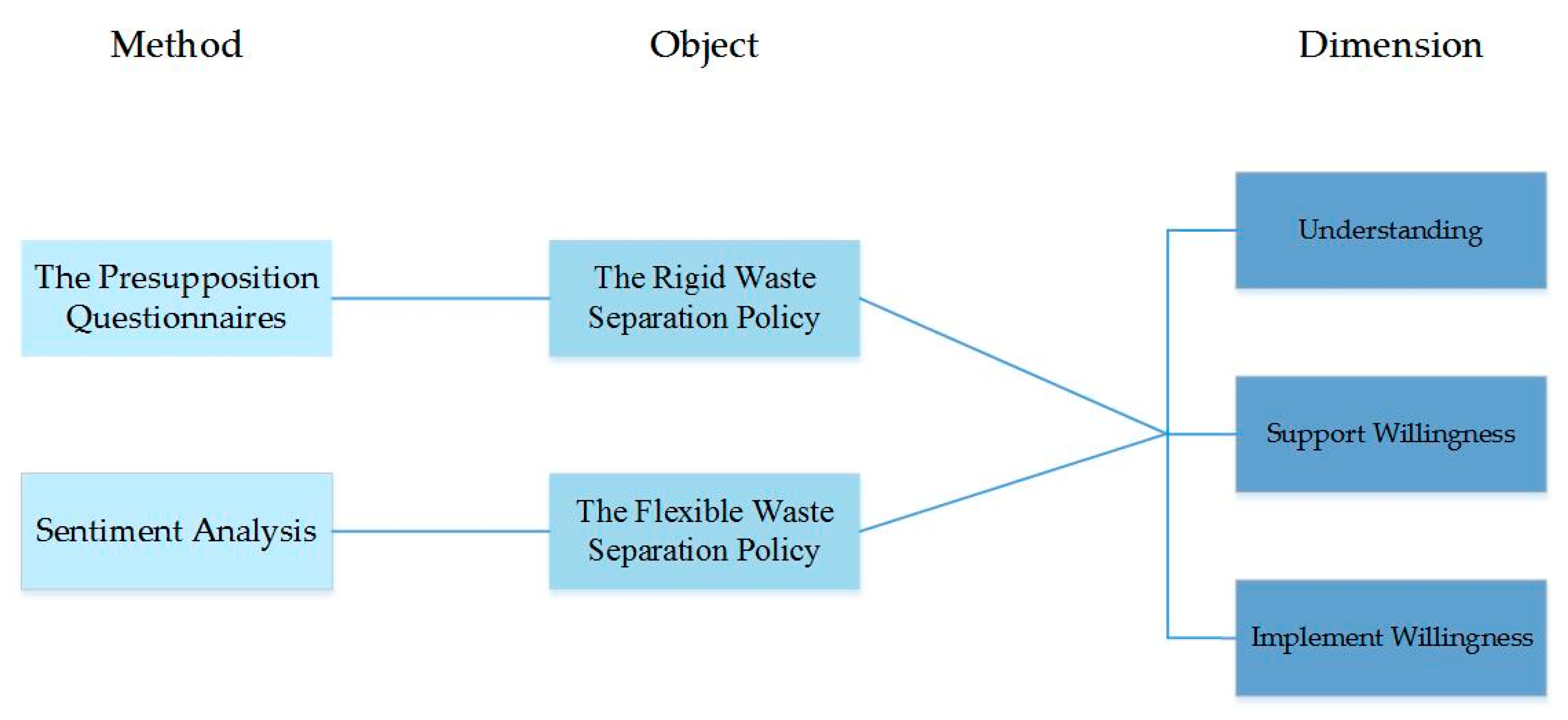
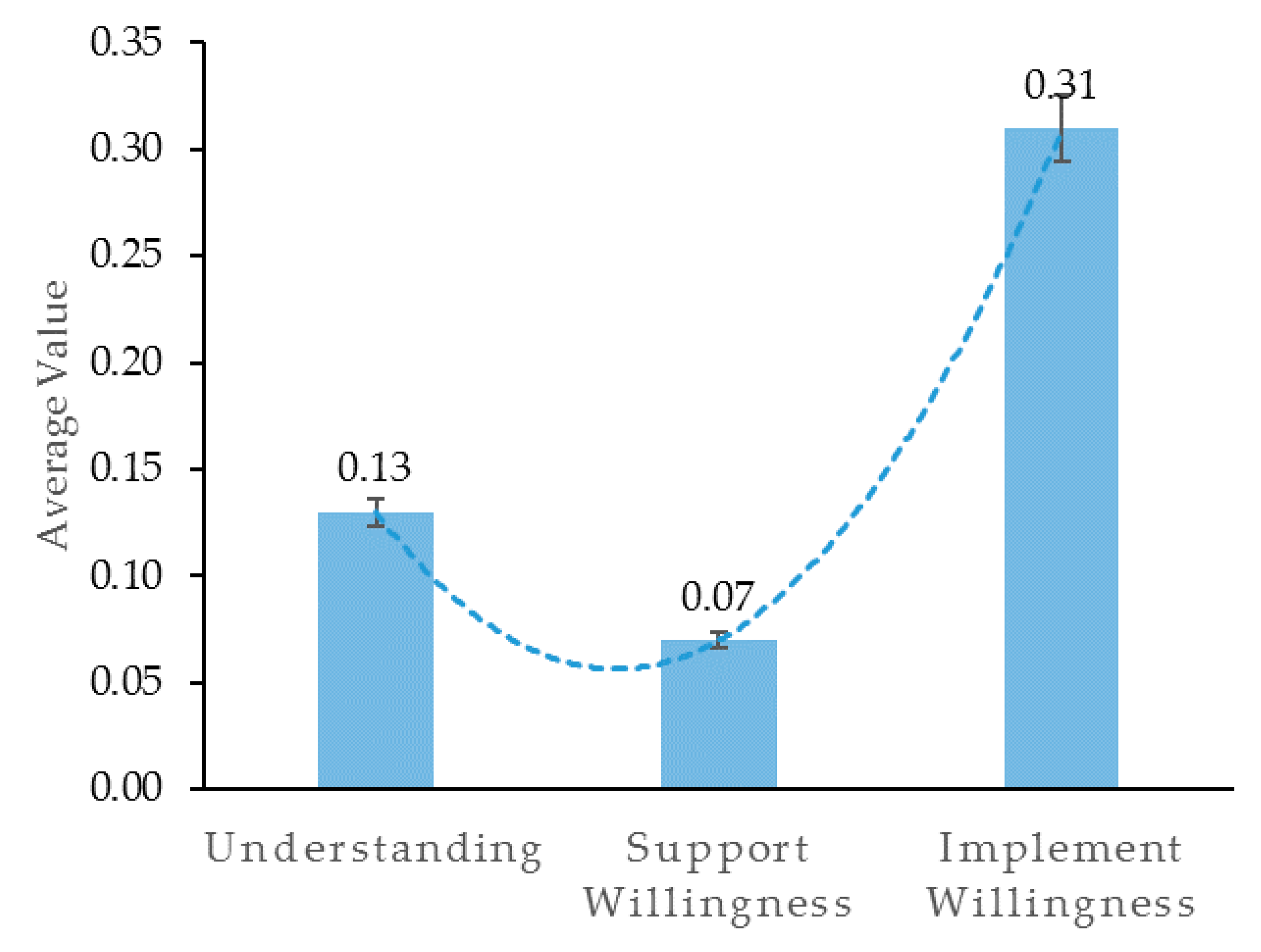
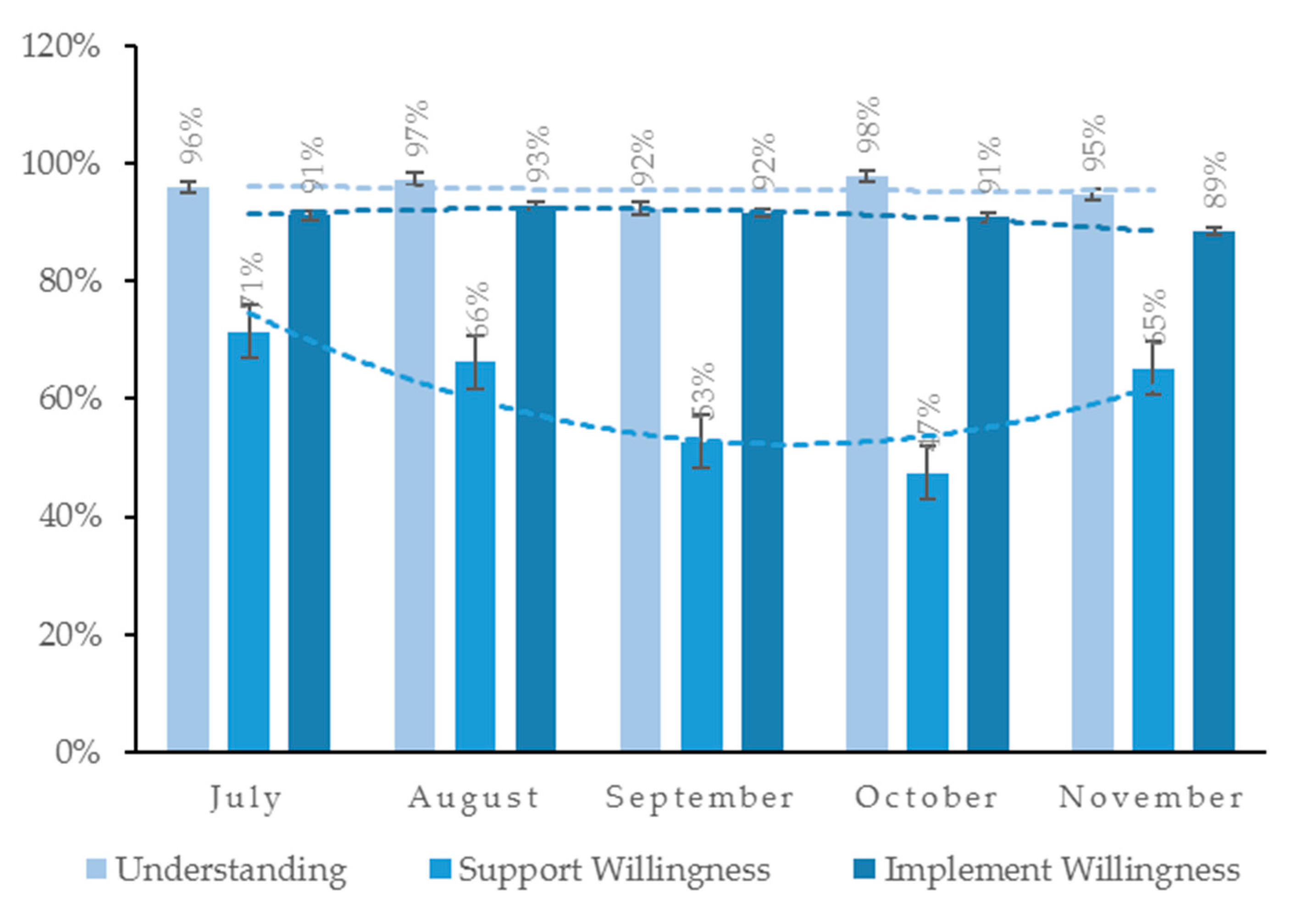

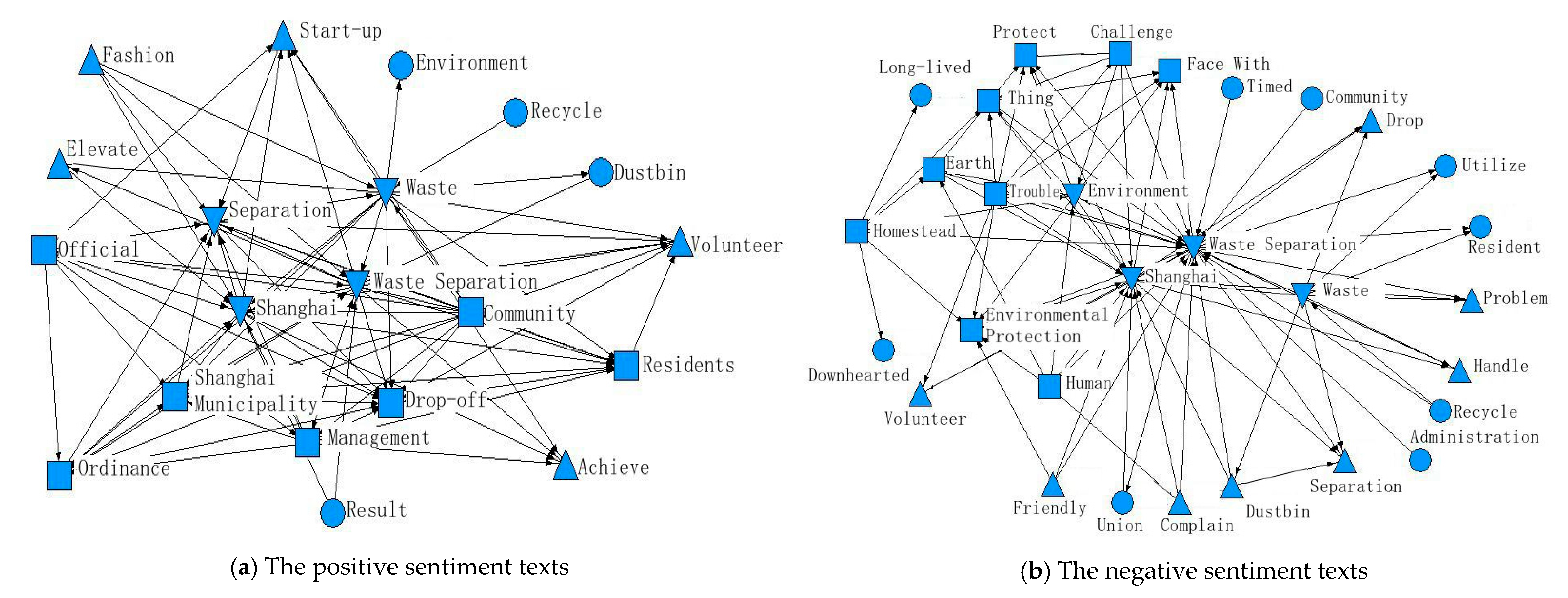
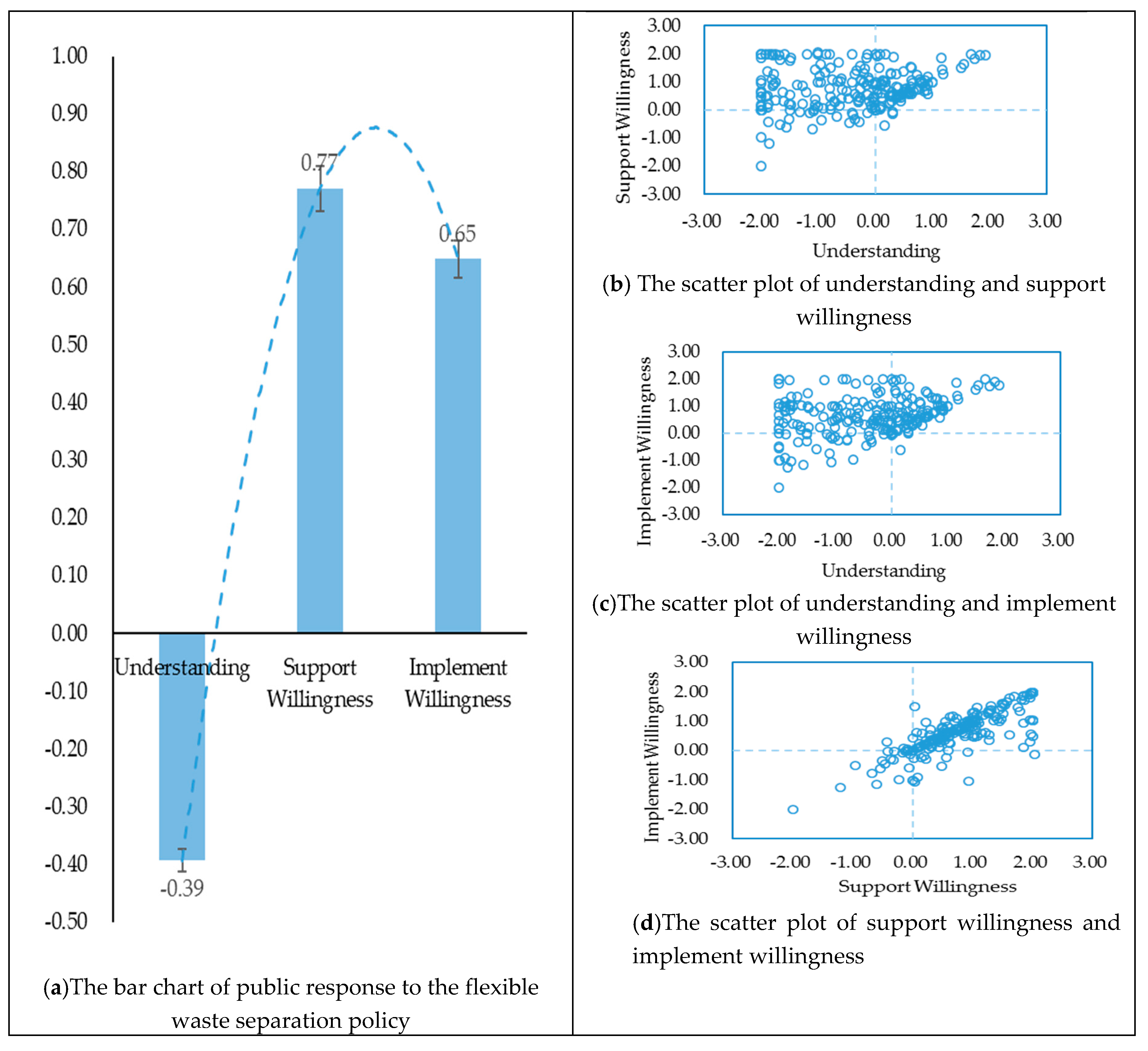
| Score | Understanding | Support Willingness | Implement Willingness |
|---|---|---|---|
| +2 | unambiguous; absolutely clear; comprehend; Understand | with admiration for; enjoy popular confidence | persist in; unremittingly; persistent; insistent |
| +1 | know; know of; hear of; know about | agree; consent; approve; approve of | try; comply with; abide by; attempt |
| −1 | unknown; unclear; uncertain; indefinite | Unsupported; disapproving; deprecated | hasty; cursory; turn a blind eye; unwilling |
| −2 | ambiguous; complex; never heard; know nothing about | terrible; awful; horrible; dreadful | give up; back-out; reluctance |
| N | Mean Value | Standard Deviation | Variance | Skewness | Kurtosis | |||
|---|---|---|---|---|---|---|---|---|
| Statistic | Statistic | Statistic | Statistic | Statistic | Standard Error | Statistic | Standard Error | |
| Understanding | 10,057 | 0.130 | 0.412 | 0.170 | 2.493 | 0.024 | 9.030 | 0.049 |
| Support Willingness | 10,057 | 0.070 | 0.621 | 0.386 | 0.393 | 0.024 | 4.971 | 0.049 |
| Implement Willingness | 10,057 | 0.310 | 0.726 | 0.527 | 1.141 | 0.024 | 1.644 | 0.049 |
| Policy Content | Measurement Content | Item Description | Not Conformed | Little Conformed | Common | Conformed | Quite Conformed |
|---|---|---|---|---|---|---|---|
| “Deposit return policy”: consumers pay a deposit of a certain amount when purchasing a product, which will be returned after the return of used products or recycling of used products. | Understanding | I understand the specifics of this policy standard | −2 | −1 | 0 | 1 | 2 |
| Support Willingness | I support this policy standard | −2 | −1 | 0 | 1 | 2 | |
| Implement Willingness | I will obey or abide by the standards of the system | −2 | −1 | 0 | 1 | 2 | |
| I will make this policy standard known to others and drive more people to follow it | −2 | −1 | 0 | 1 | 2 |
| N | Mean Value | Standard Deviation | Variance | Skewness | Kurtosis | |||
|---|---|---|---|---|---|---|---|---|
| Statistic | Statistic | Statistic | Statistic | Statistic | Standard Error | Statistic | Standard Error | |
| Understanding | 279 | −0.392 | 0.972 | 0.991 | −0.120 | 0.164 | −0.828 | 0.327 |
| Support Willingness | 279 | 0.771 | 0.621 | 0.725 | −0.128 | 0.164 | 0.194 | 0.327 |
| Implement Willingness | 279 | 0.649 | 0.726 | 0.727 | −0.304 | 0.164 | 0.518 | 0.327 |
© 2020 by the authors. Licensee MDPI, Basel, Switzerland. This article is an open access article distributed under the terms and conditions of the Creative Commons Attribution (CC BY) license (http://creativecommons.org/licenses/by/4.0/).
Share and Cite
Hou, J.; Jin, Y.; Chen, F. Should Waste Separation Be Mandatory? A Study on Public’s Response to the Policies in China. Int. J. Environ. Res. Public Health 2020, 17, 4539. https://doi.org/10.3390/ijerph17124539
Hou J, Jin Y, Chen F. Should Waste Separation Be Mandatory? A Study on Public’s Response to the Policies in China. International Journal of Environmental Research and Public Health. 2020; 17(12):4539. https://doi.org/10.3390/ijerph17124539
Chicago/Turabian StyleHou, Jing, Yujing Jin, and Feiyu Chen. 2020. "Should Waste Separation Be Mandatory? A Study on Public’s Response to the Policies in China" International Journal of Environmental Research and Public Health 17, no. 12: 4539. https://doi.org/10.3390/ijerph17124539
APA StyleHou, J., Jin, Y., & Chen, F. (2020). Should Waste Separation Be Mandatory? A Study on Public’s Response to the Policies in China. International Journal of Environmental Research and Public Health, 17(12), 4539. https://doi.org/10.3390/ijerph17124539





